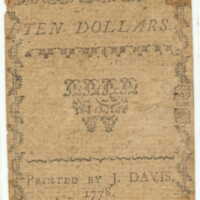North Carolina Paper Currency
Dublin Core
Title
Subject
Description
During the Colonial Period, the scarcity of specie (coin) in North Carolina constituted a major problem. Settlers arrived with little hard currency and the limited trade of the province brought in inadequate amounts of coin. Since little or no gold, silver or copper (the raw materials for coins) was mined in the colony, the chief form of exchange for most of the Colonial Period was the barter of commodities—tobacco, corn, wheat, tallow, skins, pitch, whale oil, pork and beef, etc
Paper currency was treated with some suspicion. During the Colonial Period, it was frequently issued to finance or pay off debts incurred by military expeditions. The 1748 issue, for example, paid for constructing forts at Cape Fear and Ocracoke for protection of the coastal area from Spanish attacks. Unlike specie, paper currency was subject to counterfeiting, depreciation of face value and inflation. It wasn’t easy to convince Americans to accept the early paper currency. To encourage them, famous and respected men were recruited to sign the front of the bills by hand. The signatures on the reverse often signified a guarantee of payment.
The individual most closely associated with North Carolina currency was New Bern printer James Davis (1721-1785). Born and trained in Virginia, Davis came to North Carolina in 1749 to fill the post of public printer, an office created that year by the Assembly to print a revisal of the colony’s laws. Davis opened a print shop in New Bern, first on Pollock Street and later on Broad Street. His first job was printing currency for the province—probably the Bills of Credit authorized by the Assembly on April 4th, 1748. In his capacity as public printer for North Carolina, Davis printed the succeeding issues of currency (1754, 1757/58, ______1774). While much of his work was of an official nature, Davis is credited with publishing the first North Carolina imprint. During his nearly thirty-three years as public printer, he printed at least one hundred titles. He also published a variety of other material including North Carolina’s first newspaper, The North Carolina Gazette. In 1782 he relinquished his position as public printer to his son Thomas.
--
This project is supported with federal LSTA funds made possible through a grant from the Institute of Museum and Library Services, administered by the State Library of North Carolina, a division of the Department of Cultural Resources through the North Carolina ECHO, 'Exploring Cultural Heritage Online' Digitization Grant Program.
Creator
Date
Contributor
Rights
Language
Type
Coverage
Collection Items
Paper currency, National Bank of Newberne Note (third charter period), value ten dollars
North Carolina paper currency, Bill of Credit value twenty five dollars
North Carolina paper currency, Bill of Credit value fifty dollars
North Carolina paper currency, Bill of Credit value two hundred and fifty dollars
North Carolina paper currency, Bill of Credit value five dollars
North Carolina paper currency, value one dollar
North Carolina paper currency, value one dollar
North Carolina paper currency, value two dollars
Confederate States of America paper currency, value ten dollars
Confederate States of America paper currency, value twenty dollars
Confederate States of America paper currency, value fifty dollars
North Carolina paper currency, Bill of Credit value ten dollars
North Carolina paper currency, Bill of Credit value four dollars
North Carolina paper currency, Bill of Credit value four dollars
North Carolina paper currency, value twenty dollars
Position: 3 (287 views)














